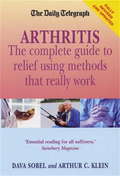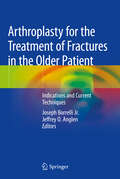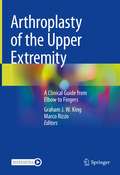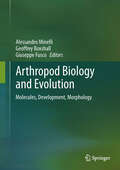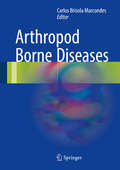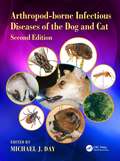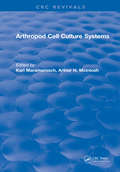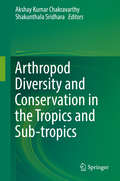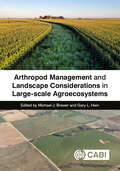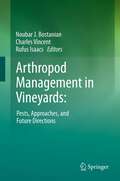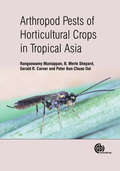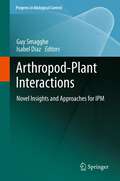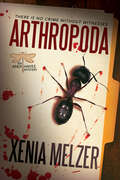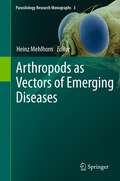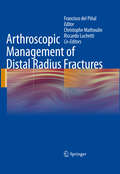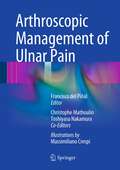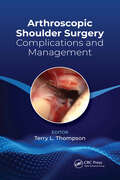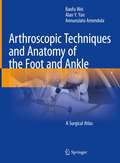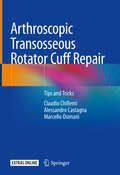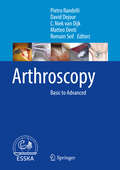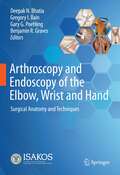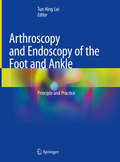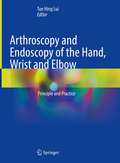- Table View
- List View
Arthritis - What Really Works: Breakthrough Relief For The Rest Of Your Life, Even After Drugs And Surgery Have Failed
by Dava Sobel Arthur KleinThose who have arthritis know there is a world of difference between the treatments that doctors recommend and those that actually work. This book, now fully revised and updated, is based on a detailed survey, in which arthritis sufferers were asked to say what best relieved their symptoms and improved their quality of life. Surgery? Nutrition? Exercise? Complementary therapies? You'll find the answers to these and many more questions in this hugely successful book. Covers: Conventional treatments, surgery and drugs; Pain-relieving techniques; Complementary therapies; Self-help techniques; Tips for managing your life and organising your home; Nutritional advice, including diet and 30-day meal plan; Includes some 200 pages of illustrated and effective exercise plans
ArthroCare
by Michael J. RobertsA young company in the medical devices area, ArthroCare, has been public for six months, and its stock--after initially performing very well--is now dropping. At the same time, the company is confronted with several tactical decisions that could impact near-term earnings and thus potentially hurt the stock price.
Arthroplasty for the Treatment of Fractures in the Older Patient: Indications and Current Techniques
by Joseph Borrelli Jr. Jeffrey O. AnglenFocusing exclusively on the older patient with poor bone quality, this unique book presents the indications, contraindications and common techniques – as well as the risks, benefits and outcomes – for utilizing arthroplasty for the treatment of fractures in this population, sensibly divided into four thematic sections. The incidence and burden of fragility fractures is presented in part one, with considerations of the influences of osteoporosis on both treatment and healing. The subsequent three sections cover upper extremity fractures, lower extremity fractures, and peri-articular nonunions, respectively. However, far from providing a simple “how-to” for the techniques discussed, the relevant current literature is presented as well as the common techniques employed in fracture management, allowing the reader to select the best approach for the specific patient presentation. In addition, chapters are included here that cover degenerative joint conditions not typically treated with total joint replacement.The treatment of fragility fractures is constantly evolving, and the aging population is consistently expanding, creating a strong need for clinicians who have experience with and exposure to the use of arthroplasty techniques as an option in their successful treatment. Written and edited by leaders in the field, Arthroplasty for the Treatment of Fractures in the Older Patient is an invaluable resource for orthopedic surgeons, residents and support staff who see and treat these increasingly common injuries.
Arthroplasty of the Upper Extremity: A Clinical Guide from Elbow to Fingers
by Graham J. W. King Marco RizzoArthroplasty of the upper extremity is an established surgical intervention in the management of arthritis of the elbow, wrist and hand. The anatomy, kinematics and demands of the elbow, wrist, thumb CMC, and finger MCP and PIP joints pose unique surgical challenges. Implant design considerations are important in providing a joint that mimics the native joints and maximizes survivorship. However, outcomes are less predictable in these upper extremity joints when compared to the hips and knees. Each joint also carries its own set of potential complications and salvage options for revision and failed arthroplasty.This unique text helps the orthopedic and hand surgeon understand the surgical approaches, unique anatomic considerations, and both the historical and current designs related to each respective joint, enabling the surgeon to better appreciate the benefits and limitations of each arthroplasty. Presenting the current state of the art, the seven sections proceed anatomically from the elbow to the fingers, with each section comprised of three thematic chapters discussing implant design considerations, primary arthroscopy techniques and revision arthroscopy techniques, including non-surgical options for treating these often difficult problems. This consistent approach, accompanied by plentiful figures, radiographs and intraoperative photos, ensures that this will be a user-friendly resource for orthopedic and hand surgeons, residents and trainees.
Arthropod Biology and Evolution: Molecules, Development, Morphology
by Alessandro Minelli, Geoffrey Boxshall and Giuseppe FuscoMore than two thirds of all living organisms described to date belong to the phylum Arthropoda. But their diversity, as measured in terms of species number, is also accompanied by an amazing disparity in terms of body form, developmental processes, and adaptations to every inhabitable place on Earth, from the deepest marine abysses to the earth surface and the air. The Arthropoda also include one of the most fashionable and extensively studied of all model organisms, the fruit-fly, whose name is not only linked forever to Mendelian and population genetics, but has more recently come back to centre stage as one of the most important and more extensively investigated models in developmental genetics. This approach has completely changed our appreciation of some of the most characteristic traits of arthropods as are the origin and evolution of segments, their regional and individual specialization, and the origin and evolution of the appendages. At approximately the same time as developmental genetics was eventually turning into the major agent in the birth of evolutionary developmental biology (evo-devo), molecular phylogenetics was challenging the traditional views on arthropod phylogeny, including the relationships among the four major groups: insects, crustaceans, myriapods, and chelicerates. In the meantime, palaeontology was revealing an amazing number of extinct forms that on the one side have contributed to a radical revisitation of arthropod phylogeny, but on the other have provided evidence of a previously unexpected disparity of arthropod and arthropod-like forms that often challenge a clear-cut delimitation of the phylum.
Arthropod Borne Diseases
by Carlos Brisola MarcondesArthropod borne diseases cause enormous morbidity and mortality in most countries, mostly in those situated in tropical areas, but also in temperate regions. This book provides organized information on all arthropod related diseases, to prevent suffering and deaths, for medical students and professionals. Since arthropod borne diseases are present in many regions of the world and can even surprise professionals and lays in non-endemic regions, like malaria in UK and Canada, the author and its many expert collaborators are sure that it will be essential in all hospitals, clinics and medical libraries around the world. As arthropod borne diseases of domesticated animals are very numerous and in some cases related to human diseases, they are also included in the book.
Arthropod-borne Infectious Diseases of the Dog and Cat
by Michael J. DayThis book is an invaluable resource for information on the clinical presentation, pathogenesis, diagnosis and treatment of major arthropod-transmitted diseases of dogs and cats. Illustrated in colour throughout, the book incorporates photographs of clinical cases, haematology, cytology and gross and microscopic pathology, which help understand the diagnosis and treatment of these diseases. The book goes beyond just covering the diseases themselves and also provides information on the arthropods that transmit them. With the effects of climate change and increasing international pet travel, this book will be a valuable addition to every small animal practitioner's library.
Arthropod Cell Culture Systems
by Karl MaramoroschInvertebrate cell culture is increasingly being used in various areas of biological research. Research in cellular biology and pathology that previously depended primarily on in vitro investigations of vertebrate animal cell systems is now being conducted using invertebrate cells. Specialists and pioneers from the United States, Japan, Switzerland, Slovakia, and China have presented original contributions to create a well-balanced cross-section of current developments. Topics discussed include the preparation of cell culture media; cultivation of mosquito, lepidopteran, grasshopper, and tick cells; the application of such cells to mammalian and plant virus research; and diverse applications in medicine, biology, and agriculture. A special chapter devoted to the work of Japanese cell culture pioneers is also featured. All chapters are supported by tables, photographs, and up-to-date bibliographies.
Arthropod Diversity and Conservation in the Tropics and Sub-tropics
by Akshay Kumar Chakravarthy Shakunthala SridharaArthropods are invertebrates that constitute over 90% of the animal kingdom, and their bio-ecology is closely linked with global functioning and survival. Arthropods play an important role in maintaining the health of ecosystems, provide livelihoods and nutrition to human communities, and are important indicators of environmental change. Yet the population trends of several arthropods species show them to be in decline. Arthropods constitute a dominant group with 1. 2 million species influencing earth's biodiversity. Among arthropods, insects are predominant, with ca. 1 million species and having evolved some 350 million years ago. Arthropods are closely associated with living and non-living entities alike, making the ecosystem services they provide crucially important. In order to be effective, plans for the conservation of arthropods and ecosystems should include a mixture of strategies like protecting key habitats and genomic studies to formulate relevant policies for in situ and ex situ conservation. This two-volume book focuses on capturing the essentials of arthropod inventories, biology, and conservation. Further, it seeks to identify the mechanisms by which arthropod populations can be sustained in terrestrial and aquatic ecosystems, and by means of which certain problematic species be managed without producing harmful environmental side-effects. This edited compilation includes chapters contributed by over 80 biologists on a wide range of topics embracing the diversity, distribution, utility and conservation of arthropods and select groups of insect taxa. More importantly, it describes in detail the mechanisms of sustaining arthropod ecosystems, services and populations. It addresses the contribution of modern biological tools such as molecular and genetic techniques regulating gene expression, as well as conventional, indigenous practices in arthropod conservation. The contributors reiterate the importance of documenting and understanding the biology of arthropods from a holistic perspective before addressing conservation issues at large. This book offers a valuable resource for all zoologists, entomologists, ecologists, conservation biologists, policy makers, teachers and students interested in the conservation of biological resources.
Arthropod Management and Landscape Considerations in Large-Scale Agroecosystems
by Matthew O'Neal Steven E. Naranjo Ian MacRae Kristopher L Giles Tom Royer Peter C Ellsworth Kristen Baum Mahendra Bhandari Haley Butler Hannalene Du Plessis Norman C. Elliott Sarah Elzay Isaac L. Esquivel Ashleigh M. Faris Aaron J. Gassmann Maura Hall Louis S. Hesler Anders S. Huseth William D. Hutchison Robert L. Meagher Jr Lance J. Meinke Shannon L. Osborne Pankaj Pal Katherine A. Parys Dominic Reisig Nina Rudin Thomas W. Sappington Gregory A. Sword Ashley E. Tessnow Paul A. Umina Johnnie Van BergFor large-scale agroecosystems, patterns of pest population increases (graded increases or abrupt outbreaks) and declines (graded suppression or abrupt crashes) vary considerably and are influenced by factors within crop fields and across broader landscape scales. Better understanding of pest population dynamics and the implications of spatial interactions on the function and development of pest management approaches are the main themes of this important book. The book builds from a 60+ year history of field-based pest management by focusing on the drivers of pest management in large-scale agroecosystems and the landscape-scale processes that affect these drivers and contribute to variation in pest outbreaks and suppression. These drivers include abiotic and biotic influences such as weather, spatial composition and arrangement of landscape elements, and widely applied managed inputs such as planting and crop rotation schedules, crop varietal selection, and land and soil conservation efforts. The book introduces general concepts, opportunities, and challenges of arthropod management in large-scale agroecosystems. Case studies from major field crop-based agroecosystems are used to present research approaches and improve understanding and management of pest and beneficial insects in large-scale agroecosystems. Specific research findings are provided on multi-trophic interactions within the system as influenced by climate, landscape, and other ecological, agricultural, and social/economic components of the agroecosystem. The book concludes with a synthesis of these concepts and prospectus for future research and developments in arthropod management in large-scale, plant-based agroecosystems. The book is essential reading for researchers in applied entomology and ecology and for pest management practitioners.
Arthropod Management in Vineyards: Pests, Approaches, and Future Directions
by Charles Vincent Rufus Isaacs Noubar J. BostanianProvides a state-of-the-science overview of arthropods affecting grape production around the world. Vineyard pest management is a dynamic and evolving field, and the contributed chapters provide insights into arthropods that limit this important crop and its products. Written by international experts from the major grape-growing regions, it provides a global overview of arthropods affecting vines and the novel strategies being used to prevent economic losses, including invasive pests affecting viticulture. The book contains reviews of the theoretical basis of integrated pest management, multiple chapters on biological control, current status of chemical control, as well as in-depth and well-illustrated reviews of the major arthropod pests affecting grape production and how they are being managed worldwide. This text will serve as a primary resource for applied entomologists, students, growers, and consultants with interests at the intersection of viticulture and applied entomology.
Arthropod Pests of Horticultural Crops in Tropical Asia
by Professor Gerald R Carner Rangaswamy Muniappan Peter Aun-Chuan Ooi Professor B. Merle ShepardAgriculture plays a pivotal role in the economy of tropical Asia, but arthropod pests are major constraints to production. This book consolidates the research on pests of South and Southeast Asia, providing useful data for the establishment of sustainable pest management programs. It covers the main arthropod pests of twenty five major crops, with colour photographs of their adult and immature stages, their distribution, biology, disease vectors, symptoms of the damage they cause and their natural enemies.
Arthropod-Plant Interactions: Novel Insights and Approaches for IPM (Progress in Biological Control #14)
by Guy Smagghe Isabel DiazThe book consists of multiple chapters by leading experts on the different aspects in the unique relationship between arthropods and plants, the underlying mechanisms, realized successes and failures of interactions and application for IPM, and future lines of research and perspectives. Interesting is the availability of the current genomes of different insects, mites and nematodes and different important plants and agricultural crops to bring better insights in the cross talk mechanisms and interacting players. This book will be the first one that integrates all this fascinating and newest (from the last 5 years) information from different leading research laboratories in the world and with perspectives from academia, government and industry.
Arthropoda (Arthropoda #1)
by Xenia MelzerAn Andi Hayes Murder MysteryDetective George Donavon doesn’t plan to stay in Charleston long. Skeptical and by-the-book, he’s on the fast track to the top, and he won’t let anything derail his career. Especially not Andrew Hayes, his grumpy, awkward new partner—and not the chief’s secret order to find out how said partner solves even the most difficult cases. George and Andi can’t agree on anything except their mutual dislike, but when three dead girls turn up at a storage unit, they must put their differences aside before the suspected trafficking ring claims another victim. There is no crime without witnesses. Andi knows George suspects his always-right “hunches” point to corruption, but he doesn’t care. All that matters is catching a killer… and keeping his secret. But with leads on this sprawling conspiracy drying up, he has no choice. He just can’t let his partner find out how he’s getting the information. Andi’s on the verge of losing his life, his mind, and his career. He could take George down with him… If the violent criminals who are always one step ahead don’t get to them first.
Arthropods as Vectors of Emerging Diseases: Arthropods As Vectors Of Emerging Diseases (Parasitology Research Monographs #3)
by Heinz MehlhornGlobal warming and globalization are the buzzwords of our time. They have nearly reached a religious status and those who deny their existence are considered modern heretics. Nevertheless, the earth has become an overcrowded village, traversable within a single day. Thus it is hardly surprising that besides persons and goods also agents of disease are easily transported daily from one end of the world to the other, threatening the health and lives of billions of humans and their animals. Agents of diseases (prions, viruses, bacteria, fungi and parasites) are not only transmitted by body contact or direct exchange of bodily fluids, but also by means of vectors which belong to the groups of licking or blood-sucking arthropods (mites, ticks, insects) that live close to humans and their houses. Without a doubt the recently accelerating globalization supports the import of agents of disease into countries where they never had been or where they had long since been eradicated, leading to a false sense of living on a "safe island." These newly imported or reintroduced diseases - called "emerging diseases" - may lead to severe outbreaks in cases where the countries are not prepared to combat them, or in cases where viruses are introduced that cannot be controlled by medications or vaccines. Arthropods are well known vectors for the spread of diseases. Thus their invasion from foreign countries and their spreading close to human dwellings must be blocked everywhere (in donor and receptor countries) using safe and effective measures. This book presents reviews on examples of such arthropod-borne emerging diseases that lurk on the fringes of our crowded megacities. The following topics show that there is an ongoing invasion of potential vectors and that control measures must be used now in order to avoid disastrous outbreaks of mass diseases.
Arthroscopic Management of Distal Radius Fractures
by Riccardo Luchetti Francisco Del Piñal Christophe MathoulinThe management of distal radius fracture has changed considerably over the past 15 years, particularly with the introduction of wrist arthroscopy and the volar locking plates. The most difficult group of fractures is those where the joint has also been involved, and for those arthroscopy plays an important role. "Arthroscopic Management of Distal Radius Fractures" will be the first one-point reference to comprehensively cover this subject. Instructively illustrated with line drawings, X-rays and clinical photos this hands-on guide depicts novel techniques in general and arthroscopic techniques in particular. The book includes chapters for beginners (e.g. anatomy of portals), as well as the step-by-step descriptions of sophisticated techniques like arthroscopic ulnar reattachment. It helps surgeons explore the possibilities of arthroscopy as well as pick up tricks, in order to master the technique. Additionally, there are chapters discussing the important findings that can only be made with the help of arthroscopy, and which bear prognostic implications and relevance.
Arthroscopic Management of Ulnar Pain
by Francisco Del Piñal Christophe Mathoulin Toshiyasu NakamuraCompared with traditional surgical procedures, wrist arthroscopy reduces the risk to patients and hastens recovery. Nevertheless, in many ways wrist arthroscopy is still in its infancy, and its indications continue to evolve. This book is devoted to the optimal use of arthroscopy in the diagnosis and treatment of wrist pathologies that give rise to ulnar pain. The correct procedure in a wide variety of settings is carefully explained in step-by-step fashion with the help of numerous detailed illustrations. Particular care is taken to cover all the important technical issues. The authors are without exception internationally acknowledged experts who draw on their considerable experience to provide readers with sound guidance on the appropriate use of arthroscopy for each indication.
Arthroscopic Shoulder Surgery: Complications and Management
by Terry ThompsonA comprehensive reference for the current surgical landscape of arthroscopic shoulder surgery, Arthroscopic Shoulder Surgery: Complications and Managementprovides expert opinions on the management of commonly encountered and unusual complications. As there is currently no other up-to-date resource dedicated wholly to complications in shoulder arthroscopy, this will become a go-to resource.Edited by Dr. Terry L. Thompson, alongside expert contributor perspectives on management and preferred treatment, Arthroscopic Shoulder Surgery is a great asset for any practicing orthopedic surgeon performing arthroscopic shoulder surgery, including fellowship-trained shoulder surgeons, sports medicine surgeons, orthopedic surgery residents, and sports medicine and shoulder fellows. By showcasing a broad range of complications and adverse outcomes, this text will assist with cases from adolescents through older adults.Each chapter in Arthroscopic Shoulder Surgery includes: Epidemiology Review of the literature Etiology Author’s preferred treatment with pearls Case presentations including radiographic and surgical images Arthroscopic Shoulder Surgery: Complications and Management is a necessary text discussing one of the most rapidly growing procedures in orthopedic surgery and meeting a need within the orthopedic community to discuss complications. Bringing together literature with tips and tricks from established leaders in shoulder surgery makes this an invaluable resource on handling complications of arthroscopic surgery of the shoulder.
Arthroscopic Techniques and Anatomy of the Foot and Ankle: A Surgical Atlas
by Annunziato Amendola Baofu Wei Alan Y. YanThis expansive, full-color atlas presents the detailed surgical anatomy and approaches for the most commonly performed arthroscopic procedures for the foot and ankle, including detailed descriptions of the equipment and operative set-up for successful arthroscopic procedures. Opening chapters discuss the relevant gross anatomy and instrumentation utilizing both cadaver and intraoperative photos, before proceeding into step-by-step presentations of nearly two dozen surgical procedures, from managing ankle instability and fractures and osteochondral lesions to peroneal tendon repair, plantar fascia release and joint arthrodesis. For each surgical procedure, indications and contraindications are provided, along with appropriate approaches and portals and possible complications. Each chapter is generously illustrated with relevant radiology and intraoperative and arthroscopic photos for maximum visual impact and ease of use, and includes a curated selection of suggested readings for further investigation. An excellent reference for foot and ankle surgeons at every skill level, Arthroscopic Techniques and Anatomy of the Foot and Ankle will be the go-to guide for years to come.
Arthroscopic Transosseous Rotator Cuff Repair: Tips and Tricks
by Claudio Chillemi Alessandro Castagna Marcello OsimaniThe book offers a comprehensive and up-to-date guide to the cutting edge arthroscopic transosseous techniques for the treatment of rotator cuff tears, which are gradually taking over from the common open surgical approach, defined as the gold standard for RCR. With the help of numerous figures, it presents step by step a novel all-arthroscopic anchorless transosseous suture technique that is less invasive and easier to perform. After discussing the etiopathogenesis, histopathology and radiological classification of rotator cuff tears, the book reviews all possible arthroscopic procedures and explores in detail suture management, describing single and double tunnel options. It also examines the complications and post-operative rehabilitation and imaging, while the closing chapter addresses the economic aspects of daily use. Intended primarily for arthroscopic surgeons interested in the field of shoulder joint repair, this exhaustive guide is also a valuable resource for residents and shoulder specialists.
Arthroscopy: Basic to Advanced
by David Dejour Pietro Randelli Matteo Denti Romain Seil C. Niek van DijkThis book, published in cooperation with ESSKA, is an exceptionally comprehensive guide to arthroscopy that covers all major joints and all potential arthroscopic procedures. Sections on the knee, shoulder, elbow, hip, wrist, and ankle provide in-depth descriptions of each procedure, including indications, technique, complications, and results, as well as essential information on diagnostic work-up and classification systems/rating scales. The text is supported by a wealth of color illustrations, and clear treatment algorithms are included for most sports injuries. An introductory section describes the history of arthroscopy, explains general principles, and provides information on instrumentation, electronic equipment, anesthesia, pain control, and prevention of complications. A special chapter focuses on the operative report, with description of an electronic form that can be used by every surgeon to store operative records or participate in European multicenter ESSKA studies. The authors include the most renowned arthroscopic surgeons in Europe. Arthroscopy will be an invaluable textbook and reference for orthopaedic surgeons, general orthopaedic physicians, sports traumatologists, residents, and physical therapists.
Arthroscopy and Endoscopy of the Elbow, Wrist and Hand: Surgical Anatomy and Techniques
by Gregory I. Bain Deepak N. Bhatia Gary G. Poehling Benjamin R. GravesThis book explores the numerous recent advances in arthroscopic and endoscopic surgery of the smaller joints of the upper extremity – elbow, wrist, and hand. Providing readers with all necessary information, i.e. relevant surgical anatomy and a clear description of technical steps, it uniquely and comprehensively presents arthroscopic and endoscopic techniques of small joints in one publication.The procedures are subdivided according to the pathology (instability, fractures, etc.) or grouped by the region within the anatomical area and include the relevant anatomy, extensive cadaveric dissections, devices and instrumentation, surgical procedures, pearls and pitfalls. High-quality colour illustrations further simplify and complement the description of surgical techniques. Written by pioneers of these techniques, the book is designed to be an up-to-date reference resource for both new and advanced orthopaedic surgeons wanting to become familiar with these techniques.
Arthroscopy and Endoscopy of the Foot and Ankle: Principle and Practice
by Tun Hing LuiThis book provides detailed information in foot and ankle arthroscopy and endoscopy. It explores and introduces these surgical techniques for the treatment of foot and ankle diseases, which have better surgical outcome, lesser surgical morbidity over conventional open surgery. In each chapter, it includes extensive cases and techniques’ illustration about arthroscopy, tendoscopy and endoscopy. Case demonstration with well-illustrated arthroscopic and endoscopic photos for common clinical conditions was provided. It is also written in the same structure and style for each techniques. Step-by-step procedures are complied with pictures and illustrations for easy reference, particularly for surgeons in their clinical practice.
Arthroscopy and Endoscopy of the Hand, Wrist and Elbow: Principle and Practice
by Tun Hing LuiThis book provides detailed advancement on arthroscopy and endoscopy of hand, wrist and elbow. It covers basic knowledge of procedures and dedicated introduction of surgical techniques for disease management. Endoscopic procedures with their advantage in surgical exposure and post-operative rehabilitation have been extensively performed in upper limb diseases. Cases presentation with well-illustrated arthroscopic and endoscopic photos for common clinical conditions was provided. The format is a step-by-step procedure for easy reference, particularly for surgeons in their training.
